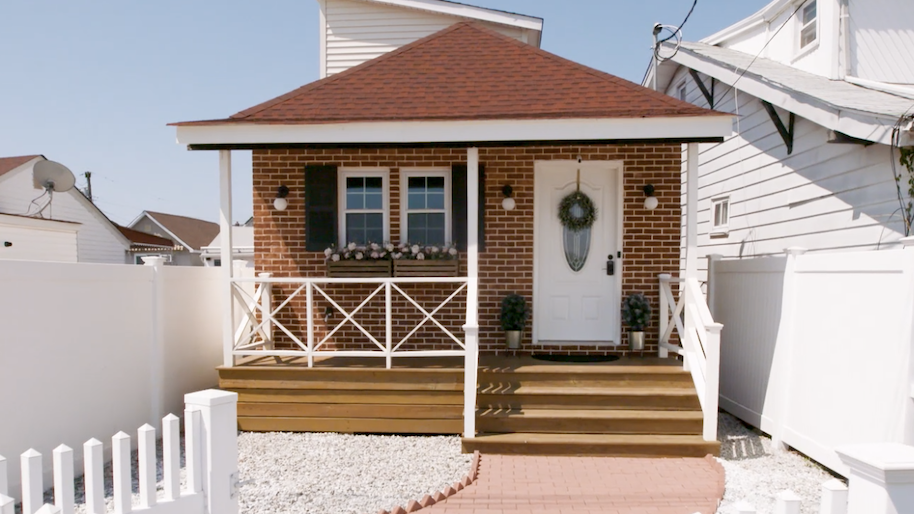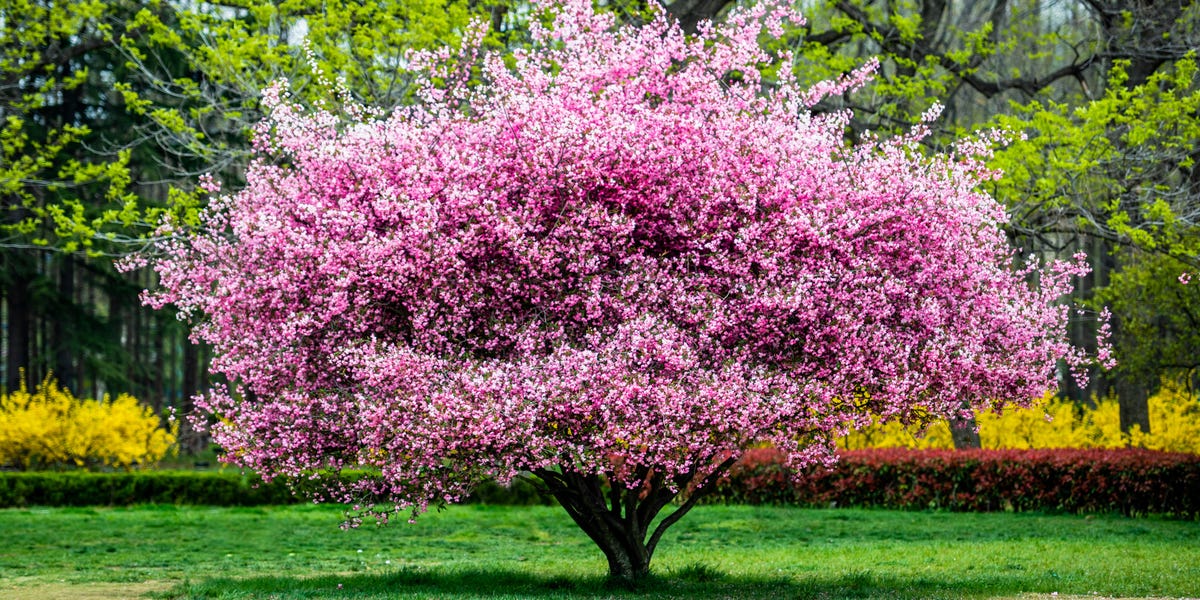Eastern Redbud

Known as the harbinger of spring, the Eastern Redbud produces hot pink flowers on unique branching patterns. Its heart-shaped leaves go from a reddish shade to dark green when summer nears, turning yellow in the fall. It’s nicely sized to fit in many gardens, with most varieties growing to around 15 to 25 feet.
USDA Hardiness Zones: 4 to 9
Related Story: 44 Inspiring Backyard Ideas to Transform Any Outdoor Living Space
Pink Oleander

Advertisement – Continue Reading Below
Pink Wisteria

Peach Tree

Before the delicious fruit appears, peach trees sprout beautiful pink blooms. Most varieties of this pink tree peak between 5 and 7 feet tall. Neighborhood critters will love the fruit, so keep that in mind.
USDA Hardiness zones: 5 to 9
Related Story: Which Fruit Trees Can You Grow in Your Yard?
Advertisement – Continue Reading Below
Cherry Blossom

Pink Trumpet

Native to equatorial countries like Mexico, Costa Rica, and Venezuela, this pink tree loves warm, dry weather. Unlike other pink trees, the pink trumpet tree blooms during the winter, and its sweet scent attracts pollinators.
USDA Hardiness zones: 10 to 11
Related Story: How to Espalier Trees and Plants
Advertisement – Continue Reading Below
Mimosa Tree

With fern-like foliage and spiky pink flowers, the mimosa tree is one of the most unique pink trees you can use in your landscaping. This tree matures at 25 to 30 feet tall with an equal spread, so be sure to plant it with plenty of room to grow.
Keep in mind that the mimosa tree is considered to be invasive in many states, so check to ensure that it’s safe to plant this tree in your area.
USDA Hardiness zone: 6 to 10
Related Story: Planting Trees Can Increase Your Home’s Value by Thousands
Gala Apple

Advertisement – Continue Reading Below
Pink Flowering Almond

A type of ornamental almond tree, the pink flowering almond tree is cultivated for its appearance rather than the edible fruit. Because of this, this tree features double the number of pink blooms as a traditional almond tree. Flowering almond trees are also more cold-tolerant than similar-looking cherry trees.
USDA Hardiness zones: 3 to 7
Related Story: The 20 Best Indoor Trees for Every Kind of Plant Parent
Red Horse Chestnut

Towering as tall as 40 feet at maturity, the red horse chestnut is great for those looking for a subtle way to incorporate pink trees into their landscaping. This tree is technically a hybrid between red buckeyes and traditional horse chestnuts. The flowers start bright red, but they’ll fade into a beautiful pink over time. Just be aware that its seeds are toxic to animals and people.
USDA Hardiness zones: 5 to 8
Related Story: 25 Beautiful Walkway Ideas to Elevate Your Home and Yard
Advertisement – Continue Reading Below
Magnolia

There are many different types of magnolias, so you can grow one just about anywhere in the United States. Southern magnolias are the classics, growing in warm regions. But you’ll also find saucer magnolias and star magnolias that grow in colder parts of the country.
USDA Hardiness zones: 3 to 10
Related Story: 85 Landscaping Ideas for an Enchanting Outdoor Space
Weeping Cherry

Advertisement – Continue Reading Below
Camellia

Camellias have a classic, old-fashioned beauty with glossy green leaves and large, lush blooms. Numerous cultivated varieties of this broadleaf evergreen bloom from late fall to early spring. Many types range from pale pink to deepest red.
USDA Hardiness zones: 7 to 9
Related Story: 27 Driveway Ideas for Every Style Home
Weigela

This large shrub, which maxes out at four to five feet tall and wide, is an excellent alternative if you don’t have room for a full-grown tree. Weigela has the most gorgeous trumpet-shaped flowers that pollinators like hummingbirds love. Some types rebloom throughout the season.
USDA Hardiness zones: 4 to 8
Related Story: 15 Most Beautiful Flowering Shrubs to Plant in Your Garden
Advertisement – Continue Reading Below
Pink Dogwood

Crabapple

Advertisement – Continue Reading Below
Crape Myrtle

There are many varieties of crape myrtle trees, but the most eye-catching blooms are pale pink, fuchsia, and red. They are super-bloomers, offering beautiful, ruffly flowers all summer long. Some varieties reach only 10 feet tall, so they’ll work in smaller landscapes.
USDA Hardiness zones: 7 to 10
Related Story: 15 Greenhouse Ideas to Complete Your Dream Garden
Oakleaf Hydrangea

Advertisement – Continue Reading Below
Rhododendron

Pink Japanese Snowbell

Watch Next

Advertisement – Continue Reading Below
Readers Also Read
Advertisement – Continue Reading Below
Advertisement – Continue Reading Below

